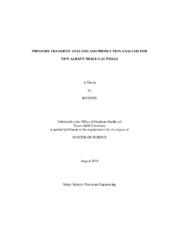| dc.contributor.advisor | Ehlig-Economics, Christine A. | |
| dc.creator | Song, Bo | |
| dc.date.accessioned | 2010-10-12T22:31:54Z | |
| dc.date.accessioned | 2010-10-14T16:08:06Z | |
| dc.date.available | 2010-10-12T22:31:54Z | |
| dc.date.available | 2010-10-14T16:08:06Z | |
| dc.date.created | 2010-08 | |
| dc.date.issued | 2010-10-12 | |
| dc.date.submitted | August 2010 | |
| dc.identifier.uri | https://hdl.handle.net/1969.1/ETD-TAMU-2010-08-8456 | |
| dc.description.abstract | Shale gas has become increasingly important to United States energy supply.
During recent decades, the mechanisms of shale gas storage and transport were gradually
recognized. Gas desorption was also realized and quantitatively described. Models and
approaches special for estimating rate decline and recovery of shale gas wells were
developed. As the strategy of the horizontal well with multiple transverse fractures
(MTFHW) was discovered and its significance to economic shale gas production was
understood, rate decline and pressure transient analysis models for this type of well were
developed to reveal the well behavior.
In this thesis, we considered a “Triple-porosity/Dual-permeability” model and
performed sensitivity studies to understand long term pressure drawdown behavior of
MTFHWs. A key observation from this study is that the early linear flow regime before
interfracture interference gives a relationship between summed fracture half-length and
permeability, from which we can estimate either when the other is known. We studied
the impact of gas desorption on the time when the pressure perturbation caused by
production from adjacent transference fractures (fracture interference time) and programmed an empirical method to calculate a time shift that can be used to qualify the
gas desorption impact on long term production behavior.
We focused on the field case Well A in New Albany Shale. We estimated the
EUR for 33 wells, including Well A, using an existing analysis approach. We applied a
unified BU-RNP method to process the one-year production/pressure transient data and
performed PTA to the resulting virtual constant-rate pressure drawdown. Production
analysis was performed meanwhile. Diagnosis plots for PTA and RNP analysis revealed
that only the early linear flow regime was visible in the data, and permeability was
estimated both from a model match and from the relationship between fracture halflength
and permeability. Considering gas desorption, the fracture interference will occur
only after several centuries. Based on this result, we recommend a well design strategy
to increase the gas recovery factor by decreasing the facture spacing. The higher EUR of
Well A compared to the vertical wells encourages drilling more MTFHWs in New
Albany Shale. | en |
| dc.format.mimetype | application/pdf | |
| dc.language.iso | en_US | |
| dc.subject | Shale Gas | en |
| dc.subject | Pressure Transient Analysis | en |
| dc.subject | Production Analysis | en |
| dc.title | Pressure Transient Analysis and Production Analysis for New Albany Shale Gas Wells | en |
| dc.type | Book | en |
| dc.type | Thesis | en |
| thesis.degree.department | Petroleum Engineering | en |
| thesis.degree.discipline | Petroleum Engineering | en |
| thesis.degree.grantor | Texas A&M University | en |
| thesis.degree.name | Master of Science | en |
| thesis.degree.level | Masters | en |
| dc.contributor.committeeMember | Valko, Peter P. | |
| dc.contributor.committeeMember | Sun, Yuefeng | |
| dc.type.genre | Electronic Thesis | en |
| dc.type.material | text | en |


